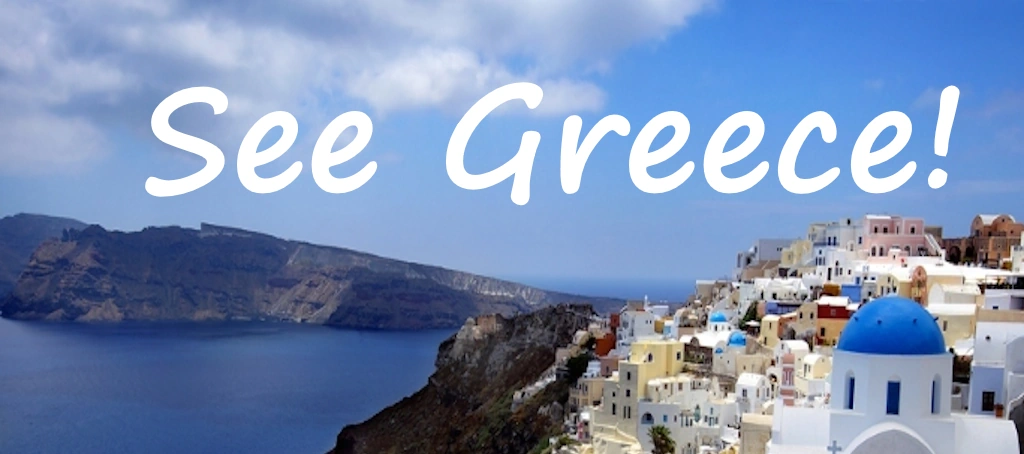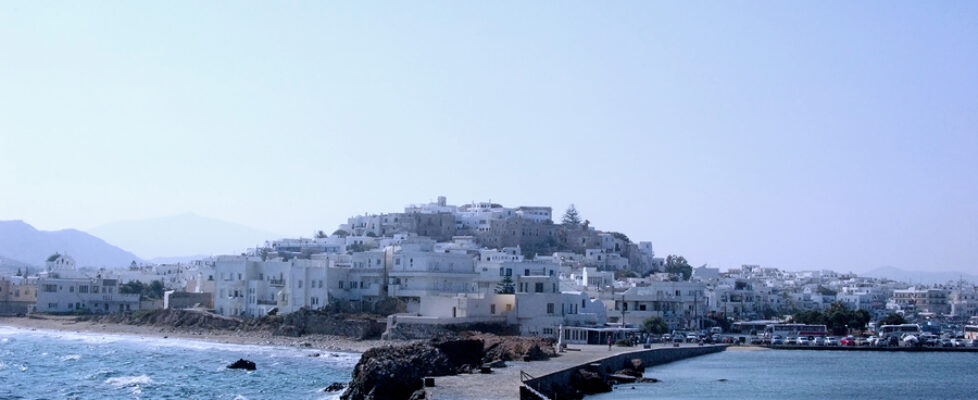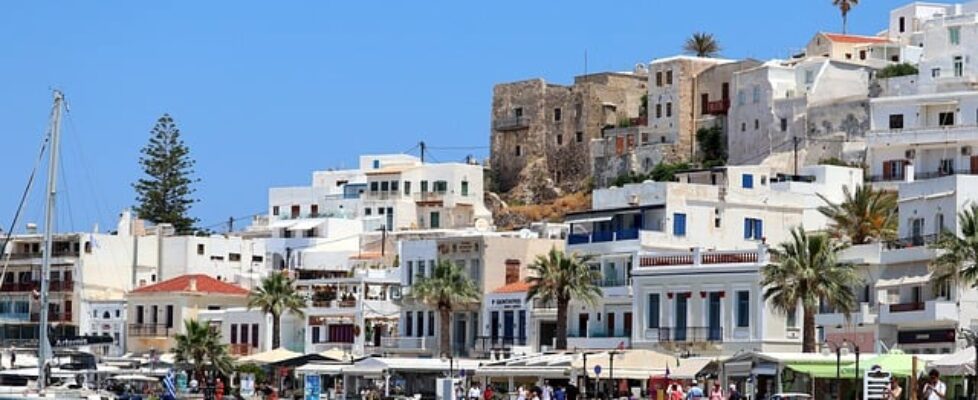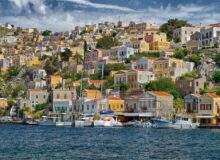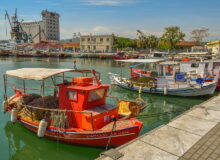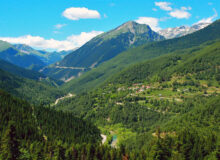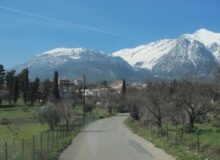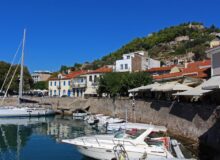Best Things to Do on Naxos
See Greece picks ten of the best things to do on Naxos in the Cyclades, including discovering the beaches, villages, and ancient ruins.

Naxos, the largest of the Cyclades islands in Greece, offers plenty of activities and attractions for visitors to enjoy. From stunning beaches and ancient ruins to charming villages and delicious cuisine, there is something for everyone on this beautiful island. Here are some of the best things to do on the Greek island of Naxos:
Ten of the Best Things to Do on Naxos
1) Explore Naxos Town (Chora)

Chora, often simply called Naxos Town, is the bustling capital and main port of Naxos, beautifully blending Cycladic charm with Venetian history. Situated on the island’s west coast, it’s a vibrant hub with a captivating old town built upon ancient ruins. The town’s architecture showcases a unique mix of whitewashed houses, narrow, winding alleys, and grand Venetian mansions.
The best things to see in Naxos Town include:
The Portara: See below.
Venetian Kastro (Castle): Perched on a hill above the town, this 13th-century fortified settlement is a labyrinth of stone-paved alleys, historic churches, and charming courtyards. Explore its medieval atmosphere, visit the Archaeological Museum housed in a former Jesuit school, and the Della Rocca-Barozzi Venetian Museum.
Old Market (Bourgos area): Wander through the bustling Old Market, a maze of shops selling local products, souvenirs, and crafts, and discover traditional tavernas and cafes.
Agios Georgios Beach: Conveniently located within Chora, this sandy beach is popular with families due to its shallow waters and offers plenty of amenities like sunbeds, umbrellas, and beachfront tavernas. It’s also a great spot for windsurfing.
2) Visit the Portara

The Portara, meaning “Great Door,” is a monumental marble gateway standing proudly on the islet of Palatia, connected to Naxos Town by a causeway. This iconic landmark is all that remains of an ambitious temple dedicated to Apollo (or possibly Dionysus), commissioned by the tyrant Lygdamis around 530 BCE but never completed due to political upheaval.
Composed of colossal marble blocks, each weighing approximately 20 tons, the Portara offers breathtaking panoramic views, especially at sunset, and serves as Naxos’s enduring symbol of ancient Greek ambition and craftsmanship
3) Relax on the Beaches
Naxos is renowned for its incredible beaches, which often stand out from other Cycladic islands due to their length and varied characteristics. Generally, Naxos beaches boast soft, fine sand and crystal-clear turquoise waters. The most popular and well-developed beaches are found on the western side of the island, offering a mix of organized stretches with amenities and more secluded, natural spots. Many beaches are shallow and calm, making them ideal for families.
Here are five of the best beaches on Naxos:
Agios Prokopios: Often hailed as one of Greece’s best beaches, Agios Prokopios is a long stretch of golden sand with incredibly clear, protected waters. It’s largely organized with sunbeds and umbrellas, and offers various water sports. Its beauty and proximity to Naxos Town make it very popular, but there are still less crowded areas towards its western end.
Plaka Beach: This is Naxos’s longest continuous stretch of sand, offering a diverse experience. The northern part is more organized with beach bars and sunbeds, while as you move south, it becomes increasingly natural and undeveloped, backed by sand dunes and sea lilies. It’s perfect for long walks and offers stunning sunsets. Parts of the southern end are known to be nudist-friendly.
Agia Anna: A charming smaller bay that’s a continuation of Agios Prokopios, Agia Anna is known for its fine sand and calm, turquoise waters. It features a picturesque fishing port and is well-organized with plenty of tavernas, cafes, and accommodation options right on the beachfront. It’s easily accessible and very lively.
Mikri Vigla: This beach is a gem, particularly for windsurfing and kitesurfing enthusiasts due to its strong, consistent winds in the northern bay (Parthena). However, its southern bay (Limanaki or Sahara) is more sheltered, offering calm, crystal-clear waters ideal for swimming and families. It’s a beautiful area with white sand and impressive rock formations.
Alyko Beach (and the Alyko Peninsula): More of an area than a single beach, Alyko is a truly unique and beautiful spot. It’s characterized by its white sand, hidden coves, and a dense cedar tree forest that is a protected Natura 2000 area. The main Alyko beach is secluded and unorganized, perfect for those seeking tranquility. The area also features the intriguing ruins of an unfinished hotel complex adorned with vibrant street art, making it a photographic delight. It’s well-protected from northern winds, offering calm swimming conditions.
4) Explore the Villages

Naxos boasts a collection of incredibly charming villages, many of them nestled in the mountains, offering a glimpse into traditional island life away from the bustling coast. Their picturesque beauty often lies in their well-preserved architecture, winding alleys, and stunning views.
Here are five of the most picturesque villages on Naxos:
Apiranthos (or Apeiranthos): Often called the “marble village,” Apiranthos is truly a jewel. Located high in the mountains, its narrow, labyrinthine streets are paved with marble, and its traditional stone houses exude an old-world charm. It has a distinctive character, seemingly untouched by time, with a rich cultural heritage showcased in its several small museums. The views of the surrounding valleys are also magnificent.
Halki (or Chalkio): Once the capital of Naxos, Halki is a beautifully preserved village in the fertile Tragea region. It’s known for its elegant Venetian-era neoclassical mansions, Byzantine churches with impressive frescoes, and its olive groves. Strolling through its picturesque alleys, visiting the Vallindras Kitron distillery (producing a local citrus liqueur), and enjoying a coffee in the main square is a delightful experience.
Filoti: Perched amphitheatrically on the slopes of Mount Zas (the highest peak in the Cyclades), Filoti is one of Naxos’s largest and most vibrant mountain villages. It offers breathtaking panoramic views and a lively central square shaded by a massive plane tree. Its traditional Cycladic architecture, narrow streets, and the impressive Church of Panagia Filotitissa with its bell tower add to its charm. It’s also a great base for hiking to Mount Zas.
Koronos: Tucked away in a deep, verdant valley in the northeastern part of the island, Koronos is a wonderfully authentic and less touristy village. It’s characterized by its steep, uphill alleys, traditional stone houses, small squares, and numerous arches. It provides a genuine insight into rural Naxian life, and its setting amidst lush greenery is particularly scenic.
Potamia (Ano, Mesa, Kato Potamia): This isn’t a single village, but rather a cluster of three small, traditional settlements (Ano, Mesa, and Kato Potamia) nestled in a lush valley with abundant water sources. They are connected by beautiful walking paths that wind through olive groves, fruit orchards, and past old watermills. The verdant landscape and the serene atmosphere make it a truly picturesque and tranquil area to explore.
5) Discover Ancient Ruins
Naxos has a rich history, and there are several ancient ruins to explore. The Temple of Demeter, dedicated to the goddess of agriculture, is a well-preserved archaeological site. The ancient city of Naxos, known as the Portara Archaeological Site, offers a glimpse into the island’s past.

6) Hike Mount Zas
Mount Zas (or Mount Zeus) is the highest peak in the Cyclades, so while it offers incredible panoramic views, it’s not a casual stroll. Its difficulty is generally rated as moderate to strenuous, depending on the route you choose and your fitness level.
Here’s a breakdown of what to expect and where the trails start:
Difficulty:
Steep and Rocky: Regardless of the route, you’ll encounter steep sections and uneven, rocky terrain. Naxos is known for its marble, so some paths can be made of slippery marble rocks.
No Shade: A significant portion of the hike, especially closer to the summit, is exposed with no shade. This makes it much harder in the summer heat, so an early morning start is highly recommended.
Loose Rocks/Scree: The final ascent to the summit can involve walking on loose scree and boulders, requiring careful footing and sometimes a bit of scrambling (using your hands for balance).
Navigation: While generally marked, some parts, especially after the Cave of Zeus, might require paying attention to rock cairns (stacked stones) or red blazes painted on rocks to stay on track.
Overall, if you’re in reasonable physical condition and have appropriate footwear (sturdy trainers or hiking shoes, not flip-flops), it’s definitely doable and rewarding. Allow 2-4 hours for the round trip, depending on your pace and how long you spend at the top.
Trail Starting Points:
There are two main starting points for hiking Mount Zas:
- Agia Marina (Easier, More Common Route):
Location: This route starts near the small country church of Agia Marina, located in the village of Danakos.
Characteristics: This is generally considered the easier and less steep of the two main routes. It’s well-marked, often with red arrows or signs.
Distance: Approximately 5 km (3 miles) round trip with about 500 meters of elevation gain.
Highlights: This route doesn’t typically pass directly by the Cave of Zeus on the way up, but you can usually take a detour to it on the descent if you wish.
Getting There: You can drive and park near the church. Some bus routes also go to the general area, but you’ll still have a short walk to the trailhead.
- Aria Spring (More Strenuous Route):
Location: This route starts near Aria Spring, which is closer to the village of Filoti.
Characteristics: This route is shorter but steeper and more rugged, involving more challenging sections and potentially more scrambling.
Highlights: This route passes directly by the Cave of Zeus (Zas Cave), a significant mythological site where Zeus is said to have been raised. If you plan to explore the cave, bring a flashlight, as phone lights won’t be sufficient.
Getting There: You can drive to Aria Spring; there’s some limited parking.
Tips for the Hike:
Start Early: Especially in summer, begin your hike in the early morning to avoid the intense heat. There’s minimal shade on the upper sections.
Plenty of Water: Carry at least 2 liters of water per person, especially during warmer months.
Sun Protection: Wear a hat, sunglasses, and apply sunscreen.
Proper Footwear: Sturdy hiking shoes or good quality trainers with ankle support are highly recommended due to the rocky and uneven terrain.
Snacks: Bring some energy-boosting snacks.
Flashlight: If you plan to explore Zeus’s Cave, a proper flashlight is essential.
Navigation: While trails are generally marked, having a map or a hiking app on your phone can be helpful.
Mount Zas is a fantastic experience for those who enjoy a challenging hike, rewarding you with unparalleled views across Naxos and the surrounding Aegean islands.
7) Taste the Local Cuisine

Naxos is known for its delicious food and local specialties. Try the famous Naxian potatoes, grown in the fertile soil of the island, or sample fresh seafood at one of the waterfront tavernas. Don’t forget to try the local cheeses, such as graviera and arseniko, and pair them with a glass of local wine.
8) See the Kouros Statues
Naxos is famous for its Kouros statues, monumental marble sculptures from the Archaic period (7th-6th centuries BCE). These colossal figures typically depict nude young men, often with one leg slightly forward, and were created as offerings in sanctuaries or as grave markers. Naxos was a major center for marble quarrying and sculpture in ancient Greece, and these unfinished kouroi provide a fascinating insight into the ancient carving process and the challenges faced by the sculptors.
The Naxian kouroi are particularly significant because they were abandoned in their quarries, giving us a unique glimpse into why such massive undertakings might have been left incomplete – often due to cracks in the marble or breakage during transport.
You can find these impressive statues in two main locations on Naxos:
- The Kouros of Apollonas (or Colossus of Dionysus):
Location: This is the largest and most famous kouros on Naxos, situated in an ancient marble quarry near the small fishing village of Apollonas, in the northern part of the island.
Description: Measuring an impressive 10.7 meters (about 35 feet) long and weighing around 80 tons, this unfinished statue is believed by many to represent the god Dionysus (though it was historically thought to be Apollo). It lies on its back, still attached to the rock from which it was being carved, with rough details of a bearded face and body visible. Its immense size likely made its transport impossible, leading to its abandonment.
- The Kouroi of Flerio (near Melanes):
Location: In the central part of the island, near the village of Melanes, specifically in the Flerio area, you’ll find two additional kouroi.
Description:
Kouros of Flerio (or Melanes Kouros): This statue is about 4.7 meters long and lies in a rural garden. It’s also unfinished, with rough outlines and visible chisel marks. Its feet are broken off, which is believed to be the reason for its abandonment during transport.
Kouros of Faranga (or Potamia Kouros/Kouros in the quarry): Located a bit further up a hill in an ancient quarry, this kouros is around 5 meters long. Like the other, its legs are broken, and it lies where it was likely dropped during an attempt to move it.
Visiting these kouroi is like stepping back in time, offering a direct connection to the ancient craftsmanship and artistic ambition of Naxos. They are often less crowded than other archaeological sites, providing a serene and thought-provoking experience.

9) Take a Boat Trip
Explore the surrounding islands and hidden coves by taking a boat trip from Naxos. Visit the neighboring islands of Paros and Mykonos, or take a day trip to the small uninhabited island of Delos, an important archaeological site.

10) Enjoy Water Sports
Naxos is a paradise for water sports enthusiasts. Try your hand at windsurfing or kitesurfing at the famous beaches of Mikri Vigla and Plaka. The island’s strong winds and calm waters make it an ideal destination for these activities.
These are just a few of the best things to do on Naxos. Whether you’re seeking relaxation, adventure, or cultural exploration, Naxos has something to offer every traveler.
